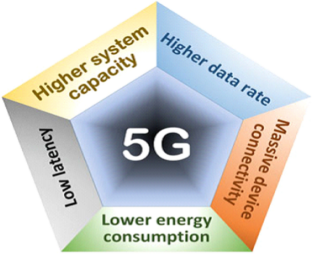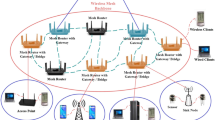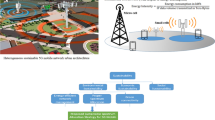Abstract
Present-day wireless methods are necessary to support a variety of higher-speed data communication facilities for its subscribers such as cloud-based video streaming facilities. One method to attain this is by using efficient resource allocation systems for transmitters and receivers using wireless communication methods. Wireless strategies and technologies are ubiquitous and enhancing progressively in the present world. In wireless communication technology, power and resource allocation remain the main issue due to the lack of resources by optimizing the number of subscribers and services. Hence, in this paper, we discuss different algorithms and techniques such as power-efficient resource allocation algorithm, real-time scheduling algorithm, NOMA, SCMA, Device-to-Device (D2D) communication, OFDMA, power and resource distribution in 5G, wireless sensor networks (WSNs), smart grids, cloud computing, and fog computing which converges stably and quickly. The Harmony search algorithm is also another way used for resources in wireless communication networks and discussed in this paper.









Similar content being viewed by others
Change history
27 May 2021
A Correction to this paper has been published: https://doi.org/10.1007/s11277-021-08606-w
References
Islam, M., & Jin, S. (2019). An overview research on wireless communication network. Networks, 5(1), 19–28.
Aggarwal, R. (2012) “Resource Allocation and Design Issues in Wireless Systems.” The Ohio State University
Kabalci, E., & Kabalci, Y. (2019). Introduction to smart grid architecture. Smart Grids and Their Communication Systems. (pp. 3–45). Springer.
Bakare, B. I., & Enoch, J. D. (2019). A review of simulation techniques for some wireless communication system. International Journal of Electronics Communication and Computer Engineering, 10(2), 60–70.
Chetal, S., Nayak, A. K., & Panigrahi, R. K. (2019, March). Multiband antenna for WLAN, WiMAX and future wireless applications. In 2019 URSI Asia-Pacific Radio Science Conference (1–4).
Sadiku, M. N. O. (2018). Optical and wireless communications: Next generation networks. . CRC Press.
Rawat, D. B., Bajracharya, C., & Yan, G. (2011). Game Theory for Resource Allocation in Wireless Networks. Emerging Technologies in Wireless Ad-hoc Networks: Applications and Future Development. (pp. 335–352). IGI Global.
Abaii, M., Liu, Y., & Tafazolli, R. (2008). An efficient resource allocation strategy for future wireless cellular systems. IEEE Transactions on Wireless Communications, 7(8), 2940–2949.
R. Cited, (2019) “(12) United States Patent,”2
Bahrami, B., Jamali, M. A. J., & Saeidi, S. (2018). A novel hierarchical architecture for Wireless Network-on-Chip. Journal of Parallel and Distributed Computing, 120, 307–321.
Kai-zhi, H., Bo, Z., & Ya-jun, C. (2019). Secrecy energy efficiency optimization in heterogeneous networks with simultaneous wireless information and power transfer ✩. Physical Communications, 37, 100848.
Nguyen, L. D. (2018). Resource allocation for energy efficiency in 5G wireless networks. EAI Endorsed Transactions on Industrial Networks and Intelligent Systems, 5(14), 1–7.
Idowu-Bismark, O., Okokpujie, K. O., Ryan, H., & Adedokun, M. O. (2019). 5G wireless communication network architecture and its key enabling technologies. International Review of Aerospace Engineering (I RE AS E), 12(2), 70–82.
Panda, S. (2020). Joint user patterning and power control optimization of MIMO–NOMA systems. Wireless Personal Communications, 112, 1-17.
Song, L., Li, Y., Ding, Z., & Poor, H. V. (2017). Resource management in non-orthogonal multiple access networks for 5G and beyond. IEEE Network, 31(4), 8–14.
Islam, S. M. R., Avazov, N., Dobre, O. A., & Kwak, K.-S. (2016). Power-domain non-orthogonal multiple access (NOMA) in 5G systems: Potentials and challenges. IEEE Communications Surveys and Tutorials, 19(2), 721–742.
Hojeij, M.-R., Farah, J., Nour, C. A., & Douillard, C. (2016). New optimal and suboptimal resource allocation techniques for downlink non-orthogonal multiple access. Wireless Personal Communications, 87(3), 837–867.
Islam, S. M. R., Zeng, M., Dobre, O. A., & Kwak, K.-S. (2018). Resource allocation for downlink NOMA systems: Key techniques and open issues. IEEE Wireless Communications, 25(2), 40–47.
Han, S., Guo, C., Meng, W., & Li, C. (2017). A flexible resource scheduling scheme for an adaptive SCMA system. Comput. Networks, 129, 384–391.
Han, S., Tai, X., Meng, W., & Li, C. (2017, May). A resource scheduling scheme based on feed-back for SCMA grant-free uplink transmission. In 2017 IEEE International Conference on Communications (ICC) (1-6)
Han, S., Huang, Y., Meng, W., Li, C., Xu, N., & Chen, D. (2018). Optimal power allocation for SCMA downlink systems based on maximum capacity. IEEE Transactions on Communications, 67(2), 1480–1489.
Yu, S., Ejaz, W., Guan, L., & Anpalagan, A. (2017). Resource allocation schemes in D2D communications: overview, classification, and challenges. Wireless Personal Communications, 96(1), 303–322.
Mishra, P. K., Kumar, A., Pandey, S., & Singh, V. P. (2018). Hybrid resource allocation scheme in multi-hop device-to-device communication for 5G networks. Wireless Personal Communications, 103(3), 2553–2573.
Dhilipkumar, S., Arunachalaperumal, C., & Thanigaivelu, K. (2019). A comparative study of resource allocation schemes for D2D networks underlay cellular networks. Wireless Personal Communications, 106(3), 1075–1087.
Kuang, Z., Liu, G., Li, G., & Deng, X. (2018). Energy efficient resource allocation algorithm in energy harvesting-based D2D heterogeneous networks. IEEE Internet of Things Journal, 6(1), 557–567.
Li, X., Zhou, L., Chen, X., Qi, A., Li, C., & Xu, Y. (2018). Resource allocation schemes based on intelligent optimization algorithms for D2D communications underlaying cellular networks. Mobile Information Systems, 1–10.
Mishra, P. K., Pandey, S., & Biswash, S. K. (2016). Efficient resource management by exploiting D2D communication for 5G networks. IEEE Access, 4, 9910–9922.
Zhou, Z., Gao, C., Xu, C., Chen, T., Zhang, D., & Mumtaz, S. (2017). Energy-efficient stable matching for resource allocation in energy harvesting-based device-to-device communications. IEEE access, 5, 15184–15196.
Hu, J., Heng, W., Li, X., & Wu, J. (2017). Energy-efficient resource reuse scheme for D2D communications underlaying cellular networks. IEEE Communications Letters, 21(9), 2097–2100.
Gao, J., Zhao, Y., Chen, M., & Chen, Z. (2019). “Resource allocation strategy based on rf energy harvesting in heterogeneous networks.” in 2019 IEEE 89th Vehicular Technology Conference (VTC2019-Spring), 1–5.
Lu, X., Wang, P., Niyato, D., & Han, Z. (2015). Resource allocation in wireless networks with RF energy harvesting and transfer. IEEE Network, 29(6), 68–75.
Wei, J., Yang, K., Zhang, G., & Lu, X. (2019). A QoS-aware joint power and subchannel allocation algorithm for mobile network virtualization. Wireless Personal Communications, 104(2), 507–526.
Jiang, H., Wang, T., & Wang, S. (2018). Multi-scale hierarchical resource management for wireless network virtualization. IEEE Transactions Cognition Communications Networks, 4(4), 919–928.
Zhu, K., & Hossain, E. (2015). Virtualization of 5G cellular networks as a hierarchical combinatorial auction. IEEE Transactions on Mobile Computing, 15(10), 2640–2654.
Ye, J., Member, S., Zhang, Y., & Member, S. (2019). Pricing-based resource allocation in virtualized cloud radio access networks. IEEE Transactions on Vehicular Technology, 68(7), 7096–7107.
Cai, Y., Yu, F. R., Liang, C., Sun, B., & Yan, Q. (2015). Software-defined device-to-device (D2D) communications in virtual wireless networks with imperfect network state information (NSI). IEEE Transactions on Vehicular Technology, 65(9), 7349–7360.
Tang, L., Yang, X., Wu, X., Cui, T., & Chen, Q. (2018). Queue stability-based virtual resource allocation for virtualized wireless networks with self-backhauls. IEEE Access, 6, 13604–13616.
Fard, S. Y. Z., Ahmadi, M. R., & Adabi, S. (2017). A dynamic VM consolidation technique for QoS and energy consumption in cloud environment. The Journal of Supercomputing, 73(10), 4347–4368.
Kamboj S. and Ghumman, N.S. (2016) “A survey on cloud computing and its types.” In 2016 3rd International Conference on Computing for Sustainable Global Development (INDIACom), 2971–2974.
Usman, M. J., et al. (2019). Energy-efficient Virtual Machine Allocation Technique Using Flower Pollination Algorithm in Cloud Datacenter: A Panacea to Green Computing. Journal of Bionic Engineering, 16(2), 354–366.
Singh, B. P., Kumar, S. A., Gao, X. Z., Kohli, M., & Katiyar, S. (2020). “A Study on energy consumption of DVFS and simple VM consolidation policies in cloud computing data centers using CloudSim toolkit.” Wireless Personal Communications 1–13
Yavari, M., Rahbar, A. G., & Fathi, M. H. (2019). Temperature and energy-aware consolidation algorithms in cloud computing. Journal of Cloud Computing, 8(1), 1–16.
Mishra, S. K., et al. (2018). Energy-efficient VM-placement in cloud data center. Sustainable Computing Informatics Systems, 20, 48–55.
Portaluri, G., Giordano, S., Kliazovich, D. and Dorronsoro, B. (2014) “A power efficient genetic algorithm for resource allocation in cloud computing data centers.” In 2014 IEEE 3rd International Conference on Cloud Networking (CloudNet), 58–63.
Makhadmeh, S. N., Khader, A. T., Al-Betar, M. A., Naim, S., Abasi, A. K., & Alyasseri, Z. A. A. (2019). Optimization methods for power scheduling problems in smart home: Survey. Renewable and Sustainable Energy Reviews, 115, 109362.
Touzene, A., Yahyai, S. A., & Oukil, A. (2019). Smart grid resources optimisation using service oriented middleware. International Journal of Computer Applications in Technology, 59(1), 53–63.
Nawaz, F., Ahmad, G., Javed, K., Khan, I., & Khan, W. (2017). An optimal Home energy management system based on time of use pricing scheme in smart grid. International Journal of Scientific and Engineering Research, 8, 882–894.
Bukhsh, R., Javaid, N., Javaid, S., Ilahi, M., & Fatima, I. (2019). Efficient resource allocation for consumers’ power requests in cloud-fog-based system. International Journal of Web and Grid Services, 15(2), 159–190.
Dunlop, T. (2019). Mind the gap: A social sciences review of energy efficiency. Energy Research & Social Science, 56, 101216.
Li, L., & Dai, S. (2010). The Influential Mechanism of Rebound Effect within Chinese Energy Efficiency. In 2010 Asia-Pacific Power and Energy Engineering Conference (1-4).
Ghosh, J. (2019). Interrelationship between energy efficiency and spectral efficiency in cognitive femtocell networks: A survey. Pervasive and Mobile Computing, 59, 101066.
Shoukat, M., Khan, B. S., Jangsher, S., Habib, A., & Bhatti, F. A. (2018). Iterative resource efficient power allocation in small cell network. Physical Communications, 30, 68–75.
Hashish, S. M. M. A., Rizk, R. Y., & Zaki, F. W. (2018). Joint energy and spectral efficient power allocation for long term evolution-advanced. Computers & Electrical Engineering, 72, 828–845.
Sun, X., & Wang, S. (2015). Resource allocation scheme for energy saving in heterogeneous networks. IEEE Transactions on Wireless Communications, 14(8), 4407–4416.
Geetha, M. N., & Mahadevaswamy, U. B. (2020). Performance Evaluation and Analysis of Peak to Average Power Reduction in OFDM Signal. Wireless Personal Communications, 112(4), 2071–2089.
Chen, S., Ren, Z., Hu, B., & Ma, W. (2015). Resource allocation in downlink OFDM wireless systems with user rate allowed regions. Wireless Personal Communications, 80(1), 429–445.
Ashourian, M., Salimian, R., & Nasab, H. M. (2013). A low complexity resource allocation method for OFDMA system based on channel gain. Wireless Personal Communications, 71(1), 519–529.
Ahmad, A., & Anwar, M. (2016). Resource allocation for OFDMA based cognitive radio networks with arbitrarily distributed finite power inputs. Wireless Personal Communications, 88(4), 839–854.
Akbari, A., Hoshyar, R. and Tafazolli, R. (2010) “Energy-efficient resource allocation in wireless OFDMA systems.” In 21st Annual IEEE International Symposium on Personal, Indoor and Mobile Radio Communications, 1731–1735.
Júnior, E. P. M. C., Vieira, L. F. M., & Vieira, M. A. M. (2019). 3DVS: Node scheduling in underwater sensor networks using 3D voronoi diagrams. Computer Networks, 159, 73–83.
Gao, X. Z., Govindasamy, V., Xu, H., Wang, X., & Zenger, K. (2015). Harmony search method: theory and applications. Computational intelligence and neuroscience.
Nazari-Heris, M., Mohammadi-Ivatloo, B., Asadi, S., Kim, J. H., & Geem, Z. W. (2019). Harmony search algorithm for energy system applications: an updated review and analysis. Journal of Experimental & Theoretical Artificial Intelligence, 31(5), 723–749.
Askarzadeh, A., & Rashedi, E. (2018). Harmony search algorithm: Basic concepts and engineering applications. Intelligent Systems: Concepts, Methodologies, Tools, and Applications. (pp. 1–30). IGI Global.
Mohd Alia, O. (2018). A dynamic harmony search-based fuzzy clustering protocol for energy-efficient wireless sensor networks. Annals of Telecommunications, 73(5), 353–365.
Kim, J. H. (2016). Harmony search algorithm: A unique music-inspired algorithm. Procedia Eng., 154, 1401–1405.
Yusup, N., Zain, A. M., & Latib, A. A. (2019). A review of Harmony search algorithm-based feature selection method for classification. Journal of Physics: Conference Series, 1192(1), 12038.
Yi, J., Lu, C., & Li, G. (2019). A literature review on latest developments of Harmony search and its applications to intelligent manufacturing. Mathematical Biosciences and Engineering, 16(4), 2086.
Ala’a, A., Alsewari, A. A., Alamri, H. S., & Zamli, K. Z. (2019). Comprehensive review of the development of the harmony search algorithm and its applications. IEEE Access, 7, 14233–14245.
Manjarres, D., et al. (2013). A survey on applications of the harmony search algorithm. Engineering Applications of Artificial Intelligence, 26(8), 1818–1831.
Geem, Z. W. (2010). State-of-the-art in the structure of harmony search algorithm. Recent advances in harmony search algorithm. (pp. 1–10). Springer.
Del Ser, J., Bilbao, M. N., Gil-López, S., Matinmikko, M., & Salcedo-Sanz, S. (2011). Iterative power and subcarrier allocation in rate-constrained orthogonal multicarrier downlink systems based on hybrid harmony search heuristics. Engineering Applications of Artificial Intelligence, 24(5), 748–756.
Hoang, D. C., Yadav, P., Kumar, R., & Panda, S. K. (2013). Real-time implementation of a harmony search algorithm-based clustering protocol for energy-efficient wireless sensor networks. IEEE Transactions on Industrial Informatics, 10(1), 774–783.
Elsied, M., Oukaour, A., Youssef, T., Gualous, H., & Mohammed, O. (2016). An advanced real time energy management system for microgrids. Energy, 114, 742–752.
Camacho-Gómez, C., Jiménez-Fernández, S., Mallol-Poyato, R., Del Ser, J., & Salcedo-Sanz, S. (2019). Optimal design of Microgrid’s network topology and location of the distributed renewable energy resources using the Harmony Search algorithm. Soft Computing, 23(15), 6495–6510.
Menon, S. (2009). A sequential approach for optimal broadcast scheduling in packet radio networks. IEEE Transactions on Communications, 57(3), 764–770.
Lin, C.-C., & Wang, P.-C. (2010). A new iterated local search algorithm for solving broadcast scheduling problems in packet radio networks. EURASIP Journal on Wireless Communications and Networking, 2010, 1–8.
Ahmad, I., Mohammad, M. G., Salman, A. A., & Hamdan, S. A. (2012). Broadcast scheduling in packet radio networks using Harmony Search algorithm. Expert Systems with Applications, 39(1), 1526–1535.
Sureshkumar, C., & Sabena, S. (2020). Fuzzy-based secure authentication and clustering algorithm for improving the energy efficiency in wireless sensor networks. Wireless Personal Communications, 112(3), 1517–1536.
Mittal, N., Singh, U., & Sohi, B. S. (2019). An energy-aware cluster-based stable protocol for wireless sensor networks. Neural Computing and Applications, 31(11), 7269–7286.
Al-Ghamdi, B., Ayaida, M., & Fouchal, H. (2020). Performance evaluation of scheduling approaches for wireless sensor networks. Wireless Personal Communications, 110(3), 1089–1108.
Lalwani, P., Das, S., Banka, H., & Kumar, C. (2018). CRHS: clustering and routing in wireless sensor networks using harmony search algorithm. Neural Computing and Applications, 30(2), 639–659.
Mann, P. S., & Singh, S. (2017). Energy-efficient hierarchical routing for wireless sensor networks: a swarm intelligence approach. Wireless Personal Communications, 92(2), 785–805.
Singh, S., & Sharma, R. M. (2018). HSCA: a novel harmony search based efficient clustering in heterogeneous WSNs. Telecommunication Systems, 67(4), 651–667.
Shankar, T., Shanmugavel, S., & Rajesh, A. (2016). Hybrid HSA and PSO algorithm for energy efficient cluster head selection in wireless sensor networks. Swarm and Evolutionary Computation, 30, 1–10.
Sharma, K. P., & Sharma, T. P. (2017). rDFD: reactive distributed fault detection in wireless sensor networks. Wireless Networks, 23(4), 1145–1160.
Sahoo, M. N., & Khilar, P. M. (2014). Diagnosis of wireless sensor networks in presence of permanent and intermittent faults. Wireless Personal Communications, 78(2), 1571–1591.
Yuvaraja, M., & Sabrigiriraj, M. (2017). Fault detection and recovery scheme for routing and lifetime enhancement in WSN. Wireless Networks, 23(1), 267–277.
Titouna, C., Aliouat, M., & Gueroui, M. (2016). FDS: fault detection scheme for wireless sensor networks. Wireless Personal Communications, 86(2), 549–562.
Mosavvar, H., & Ghaffari, A. (2018). Detecting faulty nodes in wireless sensor networks using harmony search algorithm. Wireless Personal Communications, 103(4), 2927–2945.
Karakatsanis, D. and Theodossiou, N. “Application of Modified Metaheuristic Methods to Identify Critical Areas in Water Supply Networs.”
Author information
Authors and Affiliations
Corresponding author
Additional information
Publisher's Note
Springer Nature remains neutral with regard to jurisdictional claims in published maps and institutional affiliations.
The original version of this article has been revised: The 4th and 5th authors' affiliations have been corrected.
Rights and permissions
About this article
Cite this article
Nazir, M., Sabah, A., Sarwar, S. et al. Power and Resource Allocation in Wireless Communication Network. Wireless Pers Commun 119, 3529–3552 (2021). https://doi.org/10.1007/s11277-021-08419-x
Accepted:
Published:
Issue Date:
DOI: https://doi.org/10.1007/s11277-021-08419-x




